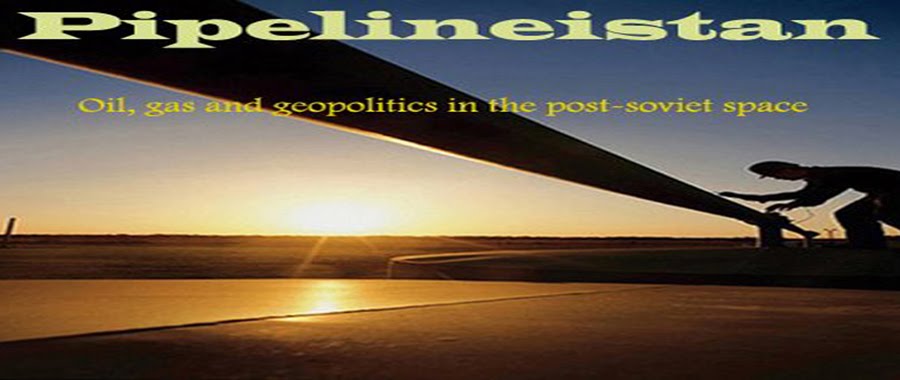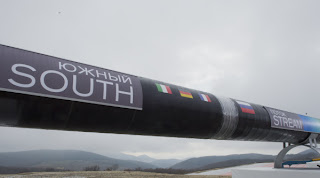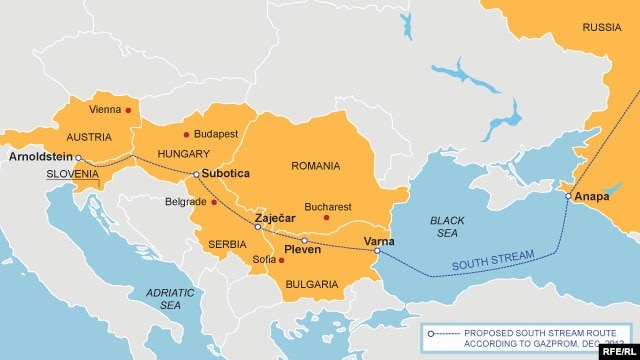Russia's Gazprom said construction
would begin this week on the underwater section of its South Stream
pipeline, which will carry natural gas beneath the Black Sea and into
the European Union.
But is this really the case?
Gazprom CEO Aleksei Miller announced last month that the final investment decision for the project had been reached. Miller attended a groundbreaking ceremony near the town of Anapa on Russia's Black Sea coast on December 7.
However, as Johnatan Stern, head of the Natural Gas Research Program at the Oxford Institute for Energy Studies notes, Gazprom hasn't yet ordered pipe or organized the lay barge for the pipeline and "cannot start laying the offshore section until 2014 [at the] earliest."
Moreover, EU officials say a final route has yet to be submitted to Brussels and likely won't have final approval for at least another year.
RFE/RL has also learned that EU Energy Commissioner Guenther Oettinger declined an invitation to attend the groundbreaking, citing previous commitments.
Marlena Holzner, the spokeswoman for the EU energy commissioner, says this means that a final investment decision on South Stream -- a phase after all designs and studies have been completed and official approvals are in hand -- isn't even in sight.
"We have no concrete information that, indeed, the final investment decision on South Stream has been taken already because normally, if you use this term in a general sense, you would have different things established before you can say it's a final investment decision," Holzner says. "And one is that you have the route.
"To the European Commission, it has never been communicated that there is a final route. That means where South Stream starts, where it ends, and which countries the exact route goes through. That has not been done," she continues. "There is no environmental impact assessment for the whole route. As far as we can see it, we don't regard this as a final investment decision."
But is this really the case?
Gazprom CEO Aleksei Miller announced last month that the final investment decision for the project had been reached. Miller attended a groundbreaking ceremony near the town of Anapa on Russia's Black Sea coast on December 7.
However, as Johnatan Stern, head of the Natural Gas Research Program at the Oxford Institute for Energy Studies notes, Gazprom hasn't yet ordered pipe or organized the lay barge for the pipeline and "cannot start laying the offshore section until 2014 [at the] earliest."
Moreover, EU officials say a final route has yet to be submitted to Brussels and likely won't have final approval for at least another year.
RFE/RL has also learned that EU Energy Commissioner Guenther Oettinger declined an invitation to attend the groundbreaking, citing previous commitments.
Marlena Holzner, the spokeswoman for the EU energy commissioner, says this means that a final investment decision on South Stream -- a phase after all designs and studies have been completed and official approvals are in hand -- isn't even in sight.
"We have no concrete information that, indeed, the final investment decision on South Stream has been taken already because normally, if you use this term in a general sense, you would have different things established before you can say it's a final investment decision," Holzner says. "And one is that you have the route.
"To the European Commission, it has never been communicated that there is a final route. That means where South Stream starts, where it ends, and which countries the exact route goes through. That has not been done," she continues. "There is no environmental impact assessment for the whole route. As far as we can see it, we don't regard this as a final investment decision."
Gazprom says South Stream will pass through Turkish waters to Bulgaria, then continue on through Serbia, Hungary, Slovenia, and Austria to tie in with the distribution network of the multinational Eni in northern Italy.
Officials in Brussels say they see South Stream's current status as moving from the "conceptual design and feasibility" stage to the "front-end engineering and design" phase.
In the latter phase, EU legislation requires numerous tasks that need approval from regulators in each country along the route and from the European Commission itself.
Russia says it has concluded intergovernmental agreements needed with each EU country involved, but the European Commission hasn't yet seen them all.
The deadline for EU states to submit those documents to Brussels is February 16, 2013. The commission then has nine months to assess the agreements and raise its doubts and concerns.
A detailed plan for the entire route must be submitted to Brussels, which also must approve environmental and social impact studies by national regulators in each EU country.
A "transboundary assessment" is also required, with input from EU states adjacent to the route. All studies require consultations with the public and authorities in each country and could take more than a year to complete.
Moreover, the offshore section of the pipeline entering Bulgaria must undergo an EU environmental-impact study to ensure it complies with environmental directives.
Russian-European Chamber of Commerce President Sergei Shuklin confirmed that the December 7 ceremony at Anapa will mostly be a ribbon-cutting affair without underwater construction activity.
"Yes, yeah, I agree with that. But it starts," Shuklin said. "Actually, by this action, Russia showed they are serious about this project. They are just going to make it happen. I'm pretty sure.... So they will have the first communications with the European Commission, with the governments of the countries participating in this project. So everything will be concluded [according to EU legislation], especially [since] Russia just became a member of the World Trade Organization."
So why did Gazprom rush to make its announcement?
Shuklin suggested it could be related to a probe launched in September by the European Commission into allegations that Gazprom engaged in anticompetitive practices in Central and Eastern Europe.
"Russia was actually surprised with the action related to Gazprom," he said. "And so probably, one of the reasons was, 'Yeah, let's just do it our way. We know people from the countries where we will build the pipe, and at this point, deal less with the European Union government.'"
Robert Cutler, a research fellow at Carleton University's Institute of European, Russian, and Eurasian Studies in Canada, maintains that Gazprom's push to announce the start of construction work on South Stream could also be related to domestic politics.
"On live Russian television, [President] Vladimir Putin gave [Prime Minister] Dmitry Medvedev a direct order: Construction of the pipeline should begin by the end of 2012," Cutler said. "There's a certain amount of prestige domestically invested now in producing some sort of result, even though physical construction of the pipeline probably was not in the cards then and certainly is not now.
"If Putin gives this order and Medvedev says, 'We'll do it,' but it doesn't end up happening, it raises questions domestically about their authority within the factions in the Kremlin and about Gazprom's credibility overall internationally."
According to Cutler, another reason is to give the appearance that South Stream is progressing faster than the Nabucco pipeline, a rival U.S.-backed project aimed at reducing Europe's dependence on Russian gas by linking the Caspian region and the Middle East to EU markets.
Gazprom says South Stream will pass through Turkish waters to Bulgaria, then continue on through Serbia, Hungary, Slovenia, and Austria to tie in with the distribution network of the multinational Eni in northern Italy.
Officials in Brussels say they see South Stream's current status as moving from the "conceptual design and feasibility" stage to the "front-end engineering and design" phase.
In the latter phase, EU legislation requires numerous tasks that need approval from regulators in each country along the route and from the European Commission itself.
Russia says it has concluded intergovernmental agreements needed with each EU country involved, but the European Commission hasn't yet seen them all.
The deadline for EU states to submit those documents to Brussels is February 16, 2013. The commission then has nine months to assess the agreements and raise its doubts and concerns.
A detailed plan for the entire route must be submitted to Brussels, which also must approve environmental and social impact studies by national regulators in each EU country.
A "transboundary assessment" is also required, with input from EU states adjacent to the route. All studies require consultations with the public and authorities in each country and could take more than a year to complete.
Moreover, the offshore section of the pipeline entering Bulgaria must undergo an EU environmental-impact study to ensure it complies with environmental directives.
Russian-European Chamber of Commerce President Sergei Shuklin confirmed that the December 7 ceremony at Anapa will mostly be a ribbon-cutting affair without underwater construction activity.
"Yes, yeah, I agree with that. But it starts," Shuklin said. "Actually, by this action, Russia showed they are serious about this project. They are just going to make it happen. I'm pretty sure.... So they will have the first communications with the European Commission, with the governments of the countries participating in this project. So everything will be concluded [according to EU legislation], especially [since] Russia just became a member of the World Trade Organization."
So why did Gazprom rush to make its announcement?
Shuklin suggested it could be related to a probe launched in September by the European Commission into allegations that Gazprom engaged in anticompetitive practices in Central and Eastern Europe.
"Russia was actually surprised with the action related to Gazprom," he said. "And so probably, one of the reasons was, 'Yeah, let's just do it our way. We know people from the countries where we will build the pipe, and at this point, deal less with the European Union government.'"
Robert Cutler, a research fellow at Carleton University's Institute of European, Russian, and Eurasian Studies in Canada, maintains that Gazprom's push to announce the start of construction work on South Stream could also be related to domestic politics.
"On live Russian television, [President] Vladimir Putin gave [Prime Minister] Dmitry Medvedev a direct order: Construction of the pipeline should begin by the end of 2012," Cutler said. "There's a certain amount of prestige domestically invested now in producing some sort of result, even though physical construction of the pipeline probably was not in the cards then and certainly is not now.
"If Putin gives this order and Medvedev says, 'We'll do it,' but it doesn't end up happening, it raises questions domestically about their authority within the factions in the Kremlin and about Gazprom's credibility overall internationally."
According to Cutler, another reason is to give the appearance that South Stream is progressing faster than the Nabucco pipeline, a rival U.S.-backed project aimed at reducing Europe's dependence on Russian gas by linking the Caspian region and the Middle East to EU markets.
(Rferl)


